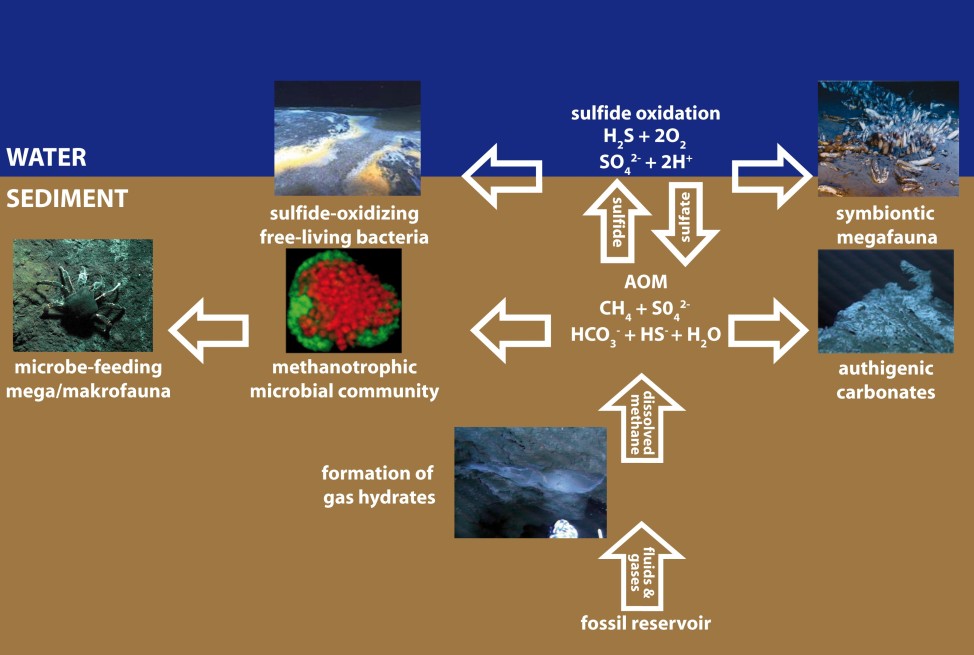 Web Content Display Web Content Display
ResultsFluid venting at continental slopes is an important mechanism for transferring fluids, volatiles and sediments from the lithosphere into the hydrosphere. Within the SFB working area off Costa Rica and Nicaragua, three major fluid venting structures have been identified as important for the submarine reflux of water and volatiles, in particular methane. These are (a) mud extrusions (or mud volcanoes and diapirs) created by the ascent of fluids, partly from great depths (Hensen et al., 2004), along faults, (b) slides caused by slope failure, and (c) scarps generated as a result of the subduction of seamounts beneath the upper plate. Chemosynthetic vent communities, authigenic carbonates, and methane plumes in the water column are manifestations of that activity. The energy provided by venting hydrocarbons (predominantly methane) is utilized by a specialized community of methane-oxidizing and sulphate-reducing microorganisms. These anaerobic microbial consortia provide sulphide, an end-product of their metabolism, which forms the basis for chemoautotrophic communities at fluid vents. Another result of their activity is the precipitation of authigenic carbonates.
From a global viewpoint, the anaerobic oxidation of methane (AOM) is important, because it removes major amounts of methane before it enters the hydrosphere (Treude et al. 2003; Treude et al. 2005; Sommer et al., 2006). Methane that bypasses this benthic filter becomes a subject of physical transport processes, partial aerobic microbial oxidation, and eventually degassing into the atmosphere, where it may contribute to global warming processes. The inventory of the methane emitted into the water column has been assessed by water-column surveys, whereas the fate of the gas can be followed by addressing its carbon stable isotopic signature (Heeschen et al., 2005; Mau et al., 2006). Among the most interesting findings of our investigations is the first assessment of fluxes from different active vent settings by in-situ lander experiments interpreted with a transport-reaction model (Linke et al., 2005). This study showed that the aerobic oxidation of methane is much less efficient than the anaerobic oxidation of methane, so that methane which is not oxidized within the sediment by AOM is almost completely released into the bottom water. Hence, anaerobic rather than aerobic methane oxidation plays the major role in the regulation of benthic methane fluxes. Moreover, we demonstrate that methane and oxygen fluxes at cold vent sites may vary up to 3 orders of magnitude over a lateral distance of only 40 cm indicating an extreme focussing of fluid flow and methane release at the seafloor. These spatial and strong temporal variations in flux rates complicate these estimates on a larger scale. Extreme methane enrichment as observed at the semi-enclosed Jaco Scarp seamount subduction site obviously decreased dramatically within only one year (between 2002 and 2003 cruises). At most sites methane emissions occur at irregularly distributed patches covered by bacterial mats. Bacterial mats usually indicate those sites where upward fluid flow rates are sufficiently high to enable high amounts of methane to bypass the benthic AOM filter. Video records of ROV dives performed during cruise M66 were used to characterize the different vent systems and determine the coverage by chemoautotrophic fauna and authigenic carbonates in these areas. As differences in the geochemical regime of cold seeps are reflected in a different composition of the chemoautotrophic community these results provide a tool for the exploration of single flux measurements at specific sites to the total flux of the whole area. |
 Events Events
Kieler Wissenschaftler fühlen den 'Puls der Erde' Wie funktioniert die Recyclingmaschine der Erde?Nach elf Jahren endet der Kieler Sonderforschungsbereich 574 zu Subduktionszonen Final colloquium of SFB 574 Teilprojekt ÖffentlichkeitsarbeitMEERESFORSCHUNG FÜR MICH UND DICH |
|
©SFB574 // Wischhofstrasse 1-3 // D-24148 Kiel // T. +49 (0)431 600 1413 // elange [AT] geomar.de






